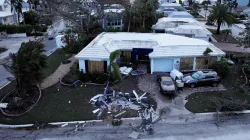Hurricane Milton exits Florida: 4 killed, homes destroyed but worst-case scenario avoided | WATCH
The category 3 storm Hurricane Milton exited Florida on Thursday morning, leaving behind a trail of destruction in the US state and causing billions in damage. However, Florida Governor Ron DeSantis said the worst-case scenario was avoided by the Category 3 storm.

Florida: The category 3 storm Hurricane Milton exited Florida and plowed into the Atlantic Ocean on Thursday after leaving behind a trail of destruction across the US state with ferocious winds and rain and over a dozen tornadoes. It caused four deaths, destroyed hundreds of homes and left millions without power, although it did not trigger the catastrophic storm surge that was largely feared after the aftermath of Hurricane Helene.
Florida Governor Ron DeSantis said at a morning briefing that the state had avoided the worst-case scenario, though he cautioned the damage was still significant. The Tampa Bay area appeared to have escaped the deadly surge of seawater that had prompted the most dire warnings. The storm brought up to 18 inches (45 centimetres) of rain to some parts of the area, said DeSantis.
“We will better understand the extent of the damage as the day progresses,” he said. “The storm was significant but thankfully, this was not the worst-case scenario.” However, officials repeated that the danger had not passed as storm surge warnings were issued for much of the east-central coast of Florida and northward into Georgia.
Houses damaged, millions left without power
Even before Milton even made landfall, heavy rain and tornadoes lashed parts of southern Florida on Wednesday morning (local time), with conditions deteriorating throughout the day. There were 19 confirmed tornados in Florida as of 8 pm on Wednesday (5:30 am Friday Indian time), about the time Milton made landfall, said DeSantis.
The four deaths occurred in St. Lucie on Florida's east coast, with at least two of those in the Spanish Lakes Communities, a set of senior neighbourhoods. More than 3 million homes and businesses in Florida were without power on Thursday morning, according to PowerOutage.us, even as some of them had been without electricity for days in the aftermath of Hurricane Helene.
Additionally, Hurricane Milton also tore a big hole in the fabric roof of Tropicana Field, the stadium of the Tampa Bay Rays baseball team in St Petersburg, although no injuries were reported in that area. "One of the blessings for us is that we did not see that predicted storm surge. That saved a lot," Tampa Mayor Jane Castor said during an early morning press conference.
In the Tampa area, the storm toppled trees and threw debris across roadways and downed power lines, video footage from local news showed. Some neighbourhoods were flooded, but the extent of the damage will not be known until crews can assess the destruction, Castor said.
Over 2,000 flights cancelled in Florida
As of Thursday morning, more than 2,000 US flights had been cancelled, according to flight-tracking website FlightAware, with the highest number of cancellations from Orlando, Tampa and southwest Florida. Florida airports remained closed for commercial flights on Thursday, including Tampa, Palm Beach and St. Pete-Clearwater.
The storm hit Florida's west coast on Wednesday night as a Category 3 hurricane on the five-step Saffir-Simpson scale, with top sustained winds of 120 mph. However, it weakened further as it crossed land, dropping to a Category 1 hurricane with top sustained winds of 85 mph (145 kph) as it reached the peninsula's east coast, the National Hurricane Center said.
Milton made landfall after much of the southern US experienced the deadly force of Hurricane Helene, the deadliest storm to hit mainland America since 2005 and killed over 200 people across six states. Both storms are expected to cause billions of dollars in damage.
(with inputs from agencies)
ALSO READ | a